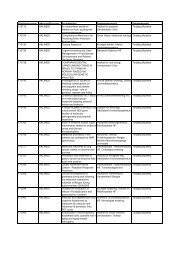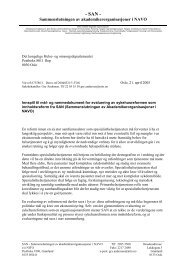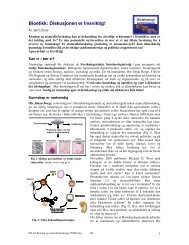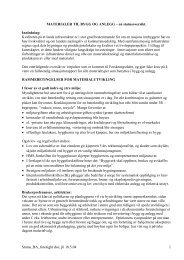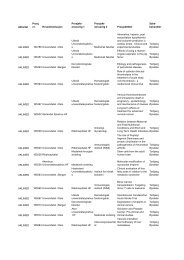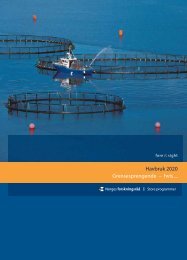A Revolution in R&D
A Revolution in R&D
A Revolution in R&D
Create successful ePaper yourself
Turn your PDF publications into a flip-book with our unique Google optimized e-Paper software.
Genomics may offer an opportunity for companies<br />
to make the correct decision more often than<br />
before. For one th<strong>in</strong>g, genomics can ultimately provide<br />
more, better, and earlier <strong>in</strong>formation, and<br />
good <strong>in</strong>formation translates ultimately <strong>in</strong>to high<br />
success rates. For another, the implementation of<br />
genomics approaches will force companies to<br />
reth<strong>in</strong>k their <strong>in</strong>ternal decision-mak<strong>in</strong>g processes.<br />
Genomics-based <strong>in</strong>formation, together with the<br />
ability to m<strong>in</strong>e it productively, gives a company an<br />
enormous advantage. Such a company will now be<br />
able to make and execute decisions on targets and<br />
<strong>in</strong>hibition, therefore, is conditional gene <strong>in</strong>hibition,<br />
which mimics the partial <strong>in</strong>hibitory effect of a drug.<br />
Several promis<strong>in</strong>g approaches have emerged, <strong>in</strong>clud<strong>in</strong>g<br />
forward genetics, chemical genomics, and<br />
molecular switches that modulate gene expression,<br />
but their practicality has still to be proved.<br />
Examples abound of genomics companies engaged <strong>in</strong><br />
develop<strong>in</strong>g these target-validation techniques. Lexicon<br />
Genetics, Exelixis, and Ingenium, for <strong>in</strong>stance,<br />
are us<strong>in</strong>g mass mutagenesis on animals such as mice<br />
and zebrafish. In a more focused project, Hypnion is<br />
us<strong>in</strong>g forward genetics and other approaches to<br />
understand sleep-wake disorders <strong>in</strong> mammals.<br />
What benefits lie <strong>in</strong> wait? By elim<strong>in</strong>at<strong>in</strong>g the false<br />
negatives associated with the current knockout technique,<br />
these new technologies could double or even<br />
triple the number of validated targets, and <strong>in</strong> that<br />
way save up to $200 million per drug. At the<br />
moment, however, these new k<strong>in</strong>ds of validation<br />
(with the exception of certa<strong>in</strong> chemical genomics<br />
approaches, discussed <strong>in</strong> the ma<strong>in</strong> text) are still<br />
ma<strong>in</strong>ly limited to “slow” biology.<br />
F<strong>in</strong>ally, structural biology is used for generat<strong>in</strong>g and<br />
analyz<strong>in</strong>g the three-dimensional structure of targets<br />
leads with greater speed and consistency than<br />
before. Guided by more rigorous selection criteria,<br />
the company should go on to improve its success<br />
rates and hence its productivity.<br />
A mere 10 percent improvement <strong>in</strong> accuracy of<br />
decisions at any stage would confer disproportionately<br />
large benefits. Consider, for example, all the<br />
target/lead pairs that fail just before cl<strong>in</strong>ical trials:<br />
if a company were able to decide <strong>in</strong> just one out of<br />
ten such cases aga<strong>in</strong>st pursu<strong>in</strong>g the target <strong>in</strong> the<br />
first place, it would save as much as $100 million<br />
per drug on average. As for INDs that fail cl<strong>in</strong>ical<br />
for virtual screen<strong>in</strong>g, and is essential to <strong>in</strong> silico drug<br />
design. Unfortunately, it currently entails prote<strong>in</strong><br />
crystallization (to prepare the prote<strong>in</strong>s for visualization<br />
by X-ray diffraction), which is a difficult, labor<strong>in</strong>tensive<br />
manual process. Speedier alternatives,<br />
such as NMR spectroscopy, cannot predict overall<br />
prote<strong>in</strong> shape adequately, be<strong>in</strong>g restricted to prote<strong>in</strong><br />
subsegments. As a result, <strong>in</strong> silico model<strong>in</strong>g rema<strong>in</strong>s<br />
limited <strong>in</strong> its applicability: the algorithms cannot<br />
boast really high precision for target classes where<br />
no example structures are available.<br />
Several projects, both public and private, are under<br />
way to upgrade structural biology platforms to the<br />
po<strong>in</strong>t where they will achieve <strong>in</strong>dustrialized scale.<br />
Among the private endeavors is the Novartis Institute<br />
for Functional Genomics, founded by Novartis to<br />
identify and characterize targets us<strong>in</strong>g high-throughput<br />
technologies. In the biotech field, Structural<br />
Genomix aims to become a platform provider and<br />
generate revenues by sell<strong>in</strong>g prote<strong>in</strong> structures; the<br />
company may also decide to exploit its data <strong>in</strong>house,<br />
and extend <strong>in</strong>to <strong>in</strong> silico drug design. But it<br />
might be several years before technologies have<br />
developed far enough for the necessary scale effects<br />
to be realized.<br />
17



